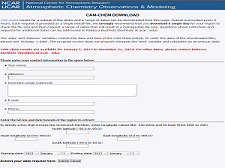These Boundary conditions are no longer produced - we recommend the new version
New Boundary Conditions: A new simulation with more consistent input data across a longer time range, and newer CESM codebase has been completed. CESM2.2:CAM-chem as Boundary Conditions
*** The dataset below is deprecated ***
Description
We have saved CAM-chem simulation output that is intended to be used as boundary conditions for regional modeling. We used CAM-chem at 0.9x1.25 horizontal resolution simulation with 56 vertical levels. Meteorology is driven by specified dynamics, by nudging with 50h relaxation (1%) to MERRA2 reanalysis. Data is saved as instantaneous fields every 6 hours. See a list of saved species. Chemistry is the MOZART-T1 mechanism, described in Emmons et al. (2019). You can find a description of all simulated species online. We use the MAM4-VBS scheme to model aerosols. Files are collected as daily information (4 time-slices per file). Anthropogenic emissions are from CMIP6, CMIP6 2014 anthropogenic emissions are repeated for dates past 2014 to 2016. Anthropogenic and "other" emissions are changed to SSP5-85 for 2017 onwards. Biogenic emissions are from online MEGAN2.1, fire emissions are from QFED CO2 x FINN emission ratios (from 2015), with emission ratios updated from 2017 onwards. Note that fire emitted DMS 2001-2015 is from CMIP6, in 2016 from GFAS and 2017 onwards from QFED. SST in 2020 are repeated from 2019.
- Data Format: netCDF
- File size: 4.8 GB per day (4 x 6-hour instantaneous time slices per day)
- Data coverage: January 1, 2001 to December 31, 2020
*** NOTE: This version of output has incorrect HCN and O3S, please do not use these species ***
Get the data
1. Subset from dates within the time period January 1, 2001 to December 31, 2020
Regional and temporal subsetting can be found at: https://www.acom.ucar.edu/cam-chem/cam-chem.shtml. Note there is a limit to download data in chunks of 32 days per download.
Direct data download of global files is also available from the NCAR Research Data Archive; registration is required.
*** Boundary conditions will not be updated with this simulation configuration past 2020 ***
For more recent dates, you could consider using the WACCM forecast for boundary conditions, which is available from January 1, 2020 to 10 days from now: https://www.acom.ucar.edu/waccm/register.shtml.
2. Alternative: All available dates January 1, 2001 to December 31, 2020
An alternate way to access any of the complete dataset of shared files between January 2001 and December 2020 is via a Globus account, which requires a Google account. Get Globus access here.
Once you can log into Globus, the boundary conditions are stored here:
January 2001 to June 2017: https://app.globus.org/file-manager?origin_id=2acef47e-ed07-11e8-8cae-0a1d4c5c824a&origin_path=%2F
January 2017 to June 2020: https://app.globus.org/file-manager?origin_id=a0e862f4-772b-11e9-bf47-0e4a062367b8&origin_path=%2F
Files can be transferred to another location using the Globus system. To set up a transfer point see the relevant page:
OSX:
https://docs.globus.org/how-to/globus-connect-personal-mac
Windows:
https://docs.globus.org/how-to/globus-connect-personal-windows
Linux:
https://docs.globus.org/how-to/globus-connect-personal-linux
Note: direct download option from this site is in beta testing phase and should be available in the future.
Reference
To cite the data directly, please use:
Buchholz, R. R., Emmons, L. K., Tilmes, S., & The CESM2 Development Team, (2019). CESM2.1/CAM-chem Instantaneous Output for Boundary Conditions. UCAR/NCAR - Atmospheric Chemistry Observations and Modeling Laboratory. Subset used† XXX, Accessed* dd mmm yyyy, https://doi.org/10.5065/NMP7-EP60.
†Please fill in the "subset used" with region and/or date of the subset you used (e.g. Lat: -10 to 10, Lon: 100 to 150, September 2015 - February 2016).
*Please fill in the "Accessed" date with the day, month, and year that you last accessed the data (e.g. - 5 Aug 2011).
We suggest to also cite the following paper that discusses the new configuration of CESM2/CAM-chem and assesses chemical species, including using output from this boundary condition simulation.
, , , , , , et al., (2020). The Chemistry Mechanism in the Community Earth System Model version 2 (CESM2). Journal of Advances in Modeling Earth Systems, 12, e2019MS001882, https://doi.org/10.1029/2019MS001882.
Other simulations
Directions to access other experimental output can be found here: Benchmarks and Production
Using the boundary conditions with WRF-Chem
The CAM-chem chemistry and aerosols for this run are identical to the WACCM forecasts. Mapping CAM-chem output to WRF-Chem chemistry schemes can be found in:
https://www2.acom.ucar.edu/sites/default/files/documents/CESM-WRFchem_aerosols_20190822.pdf
which is linked from this page:
https://www2.acom.ucar.edu/wrf-chem/wrf-chem-tools-community
